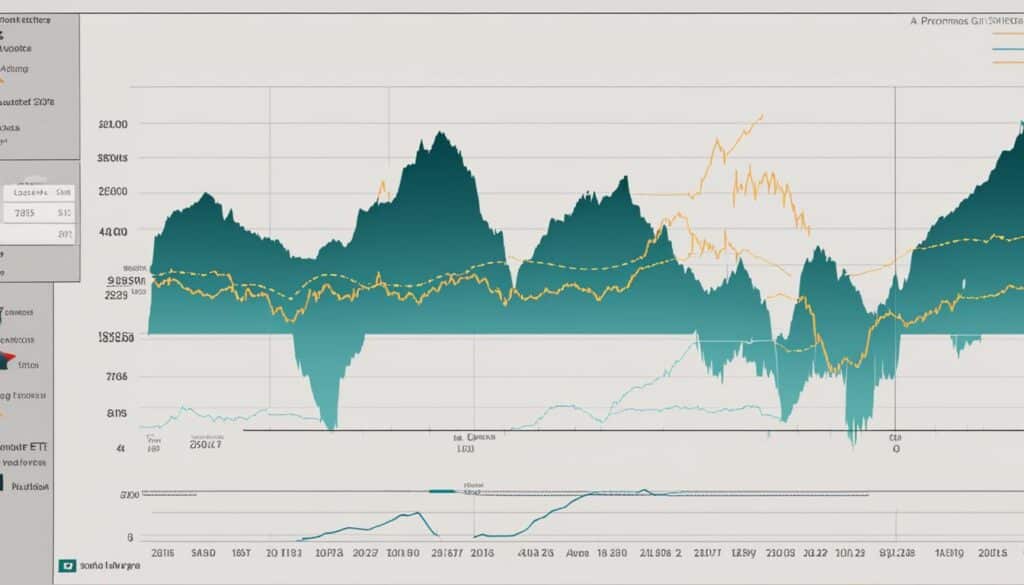Evaluating the performance of Exchange-Traded Funds (ETFs) is essential for investors to make informed decisions. To effectively analyze ETF performance, it is crucial to understand the key steps and strategies involved in performance evaluation techniques.
In this section, I will explore the process of analyzing ETF performance, including understanding performance metrics, evaluating historical performance, and assessing portfolio composition. By mastering these techniques, you can maximize the potential of your ETF investments.
Key Takeaways:
- Analysis of ETF performance allows investors to make informed decisions.
- Understanding performance metrics is vital in evaluating ETF effectiveness.
- Evaluating historical performance provides insights into market trends and patterns.
- Assessing portfolio composition helps determine risk profile and potential for growth.
- Regularly reviewing and adjusting ETF portfolios is essential for long-term success.
Understanding ETF Performance Metrics
When evaluating the performance of an Exchange-Traded Fund (ETF), understanding the various metrics that measure its performance is crucial. These metrics, known as key performance indicators (KPIs), provide valuable insights into the effectiveness of the fund. By analyzing these metrics, investors can make informed decisions and assess the relative performance of different ETFs.
“To make effective investment decisions, it’s important to utilize key performance indicators that capture the true essence of an ETF’s performance.”
One of the most commonly used ETF performance metrics is the expense ratio. The expense ratio represents the annual fee charged by the ETF provider to manage the fund. It is expressed as a percentage of the fund’s net assets and directly impacts investors’ returns. A lower expense ratio indicates a more cost-effective fund, as investors keep a larger portion of their returns.
Another important ETF performance metric is the tracking error. The tracking error measures the divergence between the ETF’s performance and its benchmark index. It indicates how closely the fund replicates the index’s returns. A lower tracking error signifies a higher level of accuracy in tracking the benchmark, indicating a well-managed fund.
The yield is another key performance indicator that provides insights into the income generated by the ETF. It is usually expressed in percentage terms and represents the income earned from dividends or interest payments. A higher yield indicates a higher income generation potential, making the fund more attractive for income-seeking investors.
In addition to these metrics, comparing the performance of an ETF against a relevant benchmark is crucial to evaluate its relative performance. By benchmarking an ETF, investors can gain a better understanding of how the fund is performing in comparison to its peers or the market as a whole.
Comparative Performance Analysis
To illustrate the significance of benchmark comparison, let’s compare the performance of two popular ETFs: Vanguard Total Stock Market ETF (VTI) and iShares S&P 500 ETF (IVV).
| Vanguard Total Stock Market ETF (VTI) | iShares S&P 500 ETF (IVV) | |
|---|---|---|
| Expense Ratio | 0.03% | 0.03% |
| Tracking Error | 0.04% | 0.03% |
| Yield | 1.25% | 1.35% |
As seen in the table above, both VTI and IVV have similar expense ratios, indicating low costs for investors. The tracking error for VTI is slightly higher than IVV, suggesting a minor deviation in replicating the benchmark’s returns. However, VTI offers a slightly lower yield compared to IVV, which may be a consideration for income-seeking investors.
By analyzing these performance metrics and comparing them against a benchmark, investors can assess the effectiveness and relative performance of different ETFs, aiding them in making well-informed investment decisions.
Analyzing Historical Performance
When it comes to evaluating the performance of an ETF, historical performance analysis plays a crucial role. By thoroughly examining the fund’s past performance, investors can identify trends, patterns, and potential risks. It provides a valuable opportunity to gain insights and make informed decisions about future investments.
One key aspect of historical performance analysis is assessing the risk-adjusted return of the ETF. This metric takes into account the fund’s returns relative to its level of risk. It provides a more accurate measure of how well the fund performed considering the volatility in the market. By analyzing risk-adjusted returns, investors can determine whether the ETF is able to generate higher returns compared to its level of risk.
Volatility is another important factor to consider during historical performance analysis. It measures the degree of price fluctuation in an ETF over a specific period. Understanding the fund’s volatility can help investors gauge its stability and potential for returns. A lower volatility indicates a more stable investment option, while higher volatility suggests potential higher returns but with increased risk.
“By analyzing historical performance indicators such as risk-adjusted return and volatility, investors can gain valuable insights into the fund’s performance during market fluctuations.”
Additionally, examining drawdowns can provide further insights into the fund’s historical performance. Drawdowns represent the peak-to-trough declines experienced by the ETF during a specific period. This analysis helps investors evaluate the fund’s ability to recover from losses and its resilience during market downturns.
By combining these historical performance metrics and conducting a thorough analysis, investors can assess the overall performance of an ETF. It allows them to make more informed investment decisions based on objective data and insights rather than relying solely on past returns.
Evaluating Portfolio Composition
Understanding the composition of an ETF’s portfolio is essential for accurate performance analysis. By conducting a comprehensive portfolio composition analysis, investors can gain valuable insights into the fund’s asset allocation, sector exposure, and geographical diversification. These factors play a significant role in determining the risk profile and potential future growth of the ETF.
When evaluating the asset allocation of an ETF, investors examine the distribution of investments across various asset classes such as equities, fixed income, cash, and commodities. This analysis provides a clear understanding of how the fund is positioned in different market segments and can help investors assess its diversification strategy. A well-diversified portfolio can lower the overall risk and increase the potential for long-term returns.
Sector exposure analysis is another crucial aspect of portfolio composition evaluation. It helps investors identify the industries and sectors that the ETF is primarily invested in. By analyzing sector weights, investors can gauge the fund’s level of concentration and potential vulnerability to specific market trends or events. A diversified sector exposure can mitigate risks associated with the performance of individual industries and improve the overall stability of the portfolio.
“Effective portfolio composition analysis allows investors to evaluate the risk profile and potential growth prospects of an ETF.”
In addition to asset allocation and sector exposure, geographical diversification analysis is an essential component of evaluating portfolio composition. It involves assessing the fund’s investments in different regions or countries. Geographical diversification helps investors reduce the impact of regional market volatility or economic downturns on their portfolios. It also provides exposure to potential growth opportunities in various international markets.
Beyond analyzing the overall composition, evaluating the individual holdings within the ETF is crucial for gaining insights into the investment strategy and potential future growth of the fund. Investors can assess the performance of each holding and determine how they align with their investment objectives and risk tolerance. This analysis helps investors make informed decisions about their ETF investments.
Example: Sector Exposure Analysis
| Sector | Weighting |
|---|---|
| Technology | 25% |
| Financials | 20% |
| Healthcare | 18% |
| Consumer Discretionary | 15% |
| Industrials | 12% |
| Others | 10% |
Table: Sector Exposure Analysis in an ETF
The example above showcases the sector exposure analysis of an ETF. It highlights the weightings of different sectors within the portfolio, allowing investors to assess the fund’s focus and potential susceptibility to sector-specific risks and opportunities.
By conducting a thorough portfolio composition analysis, investors can make well-informed decisions about their ETF investments, considering factors such as asset allocation, sector exposure, and geographical diversification. This analysis enables investors to evaluate the risk profile of the fund and identify potential growth opportunities based on their investment objectives and risk tolerance.
Conclusion
As an investor, analyzing ETF performance is essential for maximizing your investments. By employing performance evaluation techniques and understanding the various performance metrics, you can make informed decisions that align with your financial goals. Understanding the historical performance of ETFs provides valuable insights into their risk-adjusted returns and potential for future growth.
Furthermore, evaluating the composition of an ETF’s portfolio, including asset allocation and sector exposure, allows you to assess its diversification and risk profile. This analysis enables you to identify the fund’s investment strategy and its compatibility with your investment preferences.
To ensure long-term success, it is crucial to regularly review and adjust your ETF portfolio. This practice helps you adapt to changing market conditions, optimize your returns, and align your investments with your risk tolerance and investment goals. By continually analyzing ETF performance and utilizing appropriate performance evaluation techniques, you can maximize the potential of your ETF investments.
FAQ
Why is analyzing ETF performance important?
Analyzing ETF performance is crucial for investors to make informed decisions and assess the effectiveness of their investments. It provides valuable insights into the fund’s effectiveness and can help investors maximize their returns.
What are the key performance indicators to evaluate ETF performance?
The key performance indicators to evaluate ETF performance include the expense ratio, tracking error, and yield. These metrics provide valuable insights into the fund’s effectiveness and help investors assess its relative performance.
Why is historical performance analysis important for ETF evaluation?
Historical performance analysis is important for ETF evaluation as it helps investors identify trends and patterns. It allows them to evaluate risk-adjusted returns, volatility, and drawdowns over different time periods, providing insights into the fund’s performance during market fluctuations.
How can I evaluate an ETF’s portfolio composition?
To evaluate an ETF’s portfolio composition, you can analyze the asset allocation, sector exposure, and geographical diversification of the fund. This assessment helps you assess the fund’s risk profile and understand its investment strategy.
How can analyzing ETF performance maximize my investments?
Analyzing ETF performance allows you to make informed investment decisions and optimize your returns. By understanding performance metrics, historical performance, and portfolio composition, you can align your investments with your goals and risk tolerance for long-term success.
Source Links
- https://nxtmine.com/carlyle-commodities-completes-successful-drill-program-at-newton-gold-project/
- https://www.stocktitan.net/news/STM/sphere-studios-and-st-microelectronics-reveal-new-details-on-the-mb7yh617dg7q.html
Disclaimer
All information on this website is of a general nature. The information is not adapted to conditions that are specific to your person or entity. The information provided can not be considered as personal, professional or legal advice or investment advice to the user.
This website and all information is intended for educational purposes only and does not give financial advice. Signal Mastermind Signals is not a service to provide legal and financial advice; any information provided here is only the personal opinion of the author (not advice or financial advice in any sense, and in the sense of any act, ordinance or law of any country) and must not be used for financial activities. Signal Mastermind Signals does not offer, operate or provide financial, brokerage, commercial or investment services and is not a financial advisor. Rather, Signal Mastermind Signals is an educational site and a platform for exchanging Forex information. Whenever information is disclosed, whether express or implied, about profit or revenue, it is not a guarantee. No method or trading system ensures that it will generate a profit, so always remember that trade can lead to a loss. Trading responsibility, whether resulting in profits or losses, is yours and you must agree not to hold Signal Mastermind Signals or other information providers that are responsible in any way whatsoever. The use of the system means that the user accepts Disclaimer and Terms of Use.
Signal Mastermind Signals is not represented as a registered investment consultant or brokerage dealer nor offers to buy or sell any of the financial instruments mentioned in the service offered.
While Signal Mastermind Signals believes that the content provided is accurate, there are no explicit or implied warranties of accuracy. The information provided is believed to be reliable; Signal Mastermind Signals does not guarantee the accuracy or completeness of the information provided. Third parties refer to Signal Mastermind Signals to provide technology and information if a third party fails, and then there is a risk that the information may be delayed or not delivered at all.
All information and comments contained on this website, including but not limited to, opinions, analyzes, news, prices, research, and general, do not constitute investment advice or an invitation to buy or sell any type of instrument. Signal Mastermind Signals assumes no responsibility for any loss or damage that may result, directly or indirectly, from the use or dependence on such information.
All information contained on this web site is a personal opinion or belief of the author. None of these data is a recommendation or financial advice in any sense, also within the meaning of any commercial act or law. Writers, publishers and affiliates of Signal Mastermind Signals are not responsible for your trading in any way.
The information and opinions contained in the site are provided for information only and for educational reasons, should never be considered as direct or indirect advice to open a trading account and / or invest money in Forex trading with any Forex company . Signal Mastermind Signals assumes no responsibility for any decisions taken by the user to create a merchant account with any of the brokers listed on this website. Anyone who decides to set up a trading account or use the services, free of charge or paid, to any of the Broker companies mentioned on this website, bears full responsibility for their actions.
Any institution that offers a service and is listed on this website, including forex brokers, financial companies and other institutions, is present only for informational purposes. All ratings, ratings, banners, reviews, or other information found for any of the above-mentioned institutions are provided in a strictly objective manner and according to the best possible reflection of the materials on the official website of the company.
Forex/CFD trading is potentially high risk and may not be suitable for all investors. The high level of leverage can work both for and against traders. Before each Forex/CFD investment, you should carefully consider your goals, past experience and risk level. The opinions and data contained on this site should not be considered as suggestions or advice for the sale or purchase of currency or other instruments. Past results do not show or guarantee future results.
Neither Signal Mastermind Signals nor its affiliates ensure the accuracy of the content provided on this Site. You explicitly agree that viewing, visiting or using this website is at your own risk.




